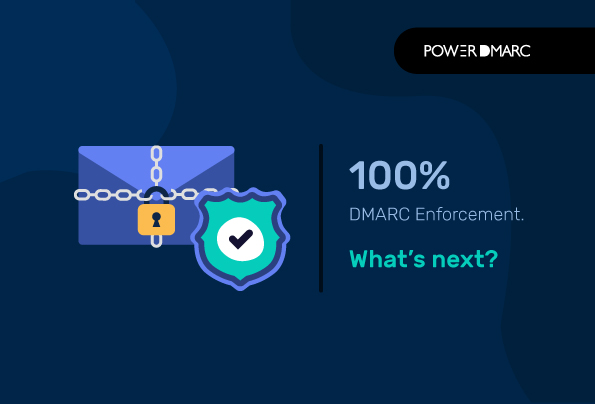All right, you’ve just gone through the whole process of setting up DMARC for your domain. You published your SPF, DKIM and DMARC records, you analysed all your reports, fixed delivery issues, bumped up your enforcement level from p=none to quarantine and finally to reject. You’re officially 100% DMARC-enforced. Congratulations! Now only your emails reach people’s inboxes. No one’s going to impersonate your brand if you can help it.
So that’s it, right? Your domain’s secured and we can all go home happy, knowing your emails are going to be safe. Right…?
Well, not exactly. DMARC is kind of like exercise and diet: you do it for a while and lose a bunch of weight and get some sick abs, and everything’s going great. But if you stop, all those gains you just made are slowly going to diminish, and the risk of spoofing starts creeping back in. But don’t freak out! Just like with diet and exercise, getting fit (ie. getting to 100% enforcement) is the hardest part. Once you’ve done that, you just need to maintain it on that same level, which is much easier.
Okay, enough with the analogies, let’s get down to business. If you’ve just implemented and enforced DMARC on your domain, what’s the next step? How do you continue keeping your domain and email channels secure?
What to Do After Achieving DMARC Enforcement
The #1 reason that email security doesn’t simply end after you reach 100% enforcement is that attack patterns, phishing scams, and sending sources are always changing. A popular trend in email scams often doesn’t even last longer than a couple of months. Think of the WannaCry ransomware attacks in 2018, or even something as recent as the WHO Coronavirus phishing scams in early 2020. You don’t see much of those in the wild right now, do you?
Cybercriminals are constantly changing their tactics, and malicious sending sources are always changing and multiplying, and there’s not much you can do about it. What you can do is prepare your brand for any possible cyberattack that could come at you. And the way to do that is through DMARC monitoring & visibility .
Even after you’re enforced, you still need to be in total control of your email channels. That means you have to know which IP addresses are sending emails through your domain, where you’re having issues with email delivery or authentication, and identify and respond to any potential spoofing attempt or malicious server carrying a phishing campaign on your behalf. The more you monitor your domain, the better you’ll come to understand it. And consequently, the better you’ll be able to secure your emails, your data and your brand.
Why DMARC Monitoring is So Important
Identifying new mail sources
When you monitor your email channels, you’re not just checking to see if everything’s going okay. You’re also going to be looking for new IPs sending emails from your domain. Your organization might change its partners or third party vendors every so often, which means their IPs might become authorized to send emails on your behalf. Is that new sending source just one of your new vendors, or is it someone trying to impersonate your brand? If you analyse your reports regularly, you’ll have a definite answer to that.
PowerDMARC lets you view your DMARC reports according to every sending source for your domain.
Understanding new trends of domain abuse
As I mentioned earlier, attackers are always finding new ways to impersonate brands and trick people into giving them data and money. But if you only ever look at your DMARC reports once every couple of months, you’re not going to notice any telltale signs of spoofing. Unless you regularly monitor the email traffic in your domain, you won’t notice trends or patterns in suspicious activity, and when you are hit with a spoofing attack, you’ll be just as clueless as the people targeted by the email. And trust me, that’s never a good look for your brand.
Find and blacklist malicious IPs
It’s not enough just to find who exactly is trying to abuse your domain, you need to shut them down ASAP. When you’re aware of your sending sources, it’s much easier to pinpoint an offending IP, and once you’ve found it, you can report that IP to their hosting provider and have them blacklisted. This way, you permanently eliminate that specific threat and avoid a spoofing attack.
With Power Take Down, you find the location of a malicious IP, their history of abuse, and have them taken down.
Control over deliverability
Even if you were careful to bring DMARC up to 100% enforcement without affecting your email delivery rates, it’s important to continuously ensure consistently high deliverability. After all, what’s the use of all that email security if none of the emails are making it to their destination? By monitoring your email reports, you can see which ones passed, failed or didn’t align with DMARC, and discover the source of the problem. Without monitoring, it would be impossible to know if your emails are being delivered, let alone fix the issue.
PowerDMARC gives you the option of viewing reports based on their DMARC status so you can instantly identify which ones didn’t make it through.
Our cutting-edge platform offers 24×7 domain monitoring and even gives you a dedicated security response team that can manage a security breach for you. Learn more about PowerDMARC extended support.
